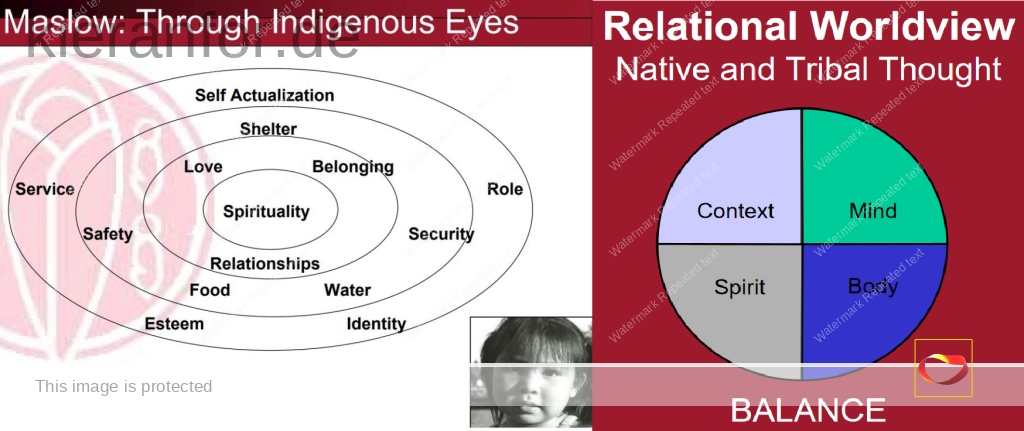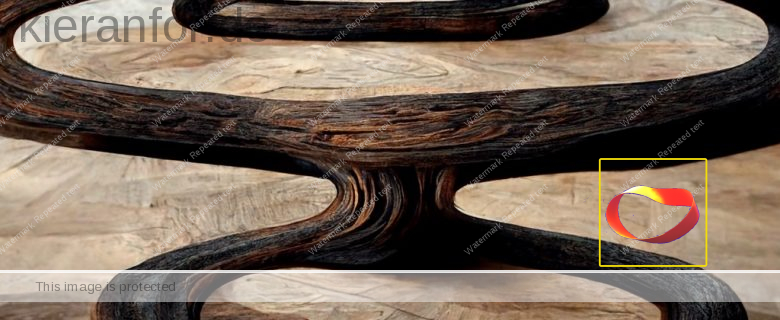Header image: KF in Dall-E
- The pyramid that has become commonly known as “Maslow’s Hierarchy of Needs” never actually appears in Maslow’s original work.
- Maslow spent time (6 weeks) with the Blackfoot people (at the Siksika Indian Reserve #146, Alberta) in the summer of 1938. A 1966 essay shows that Maslow had, by then, changed his view on the individualized nature of the hierarchy he had earlier envisaged and saw more clearly that community and culture were the “higher order” of things.
The readings below are listed in chronological order.
Heavy Head, R. (2007) How First Nations Helped Develop a Keystone of Modern Psychology. Social Science and Humanities Research Council. Online 3-10-18.
- When he visited the Blackfoot nation in the 1930s, he assumed that there was a big difference between European knowledge, which he saw as rigorously scientific, and Aboriginal knowledge, which he saw as folklore.
- This pyramid-shaped “hierarchy of needs” appears to have been inspired by Blackfoot tepees [ﻼF: A claim {convincingly} disputed by Blackfoot Scholar Ryan Heavy Head, see below], which depict a similar hierarchy, from the mushrooms struggling in the dirt along the bottom to the celestial beings depicted at the apex.
╬
Cross, T. (2007). Through Indigenous Eyes: Rethinking Theory and Practice. Keynote Address.

╬
Blackstock, C. (2011). The Emergence of the Breath of Life Theory. Journal of Social Work Values and Ethics, (8)11.
https://indigenouslanguagelearning.ca/wp-content/uploads/2017/11/Blackstock-C_2011_The-emergence-of-breath-of-life-theory.pdf
- Original link ⬆ is now broken. Archived link here: https://web.archive.org/web/20220128065523/https://indigenouslanguagelearning.ca/wp-content/uploads/2017/11/Blackstock-C_2011_The-emergence-of-breath-of-life-theory.pdf I do not believe my few notes below are in breach of the republication note at the top of the article. If I am mistaken, please let me know: mail@kieranfor.de
- Maslow’s work was, in turn, informed by the time he spent with the Blackfoot Indians in Canada (Coon, 2006).
- As shown in Figure 1, Maslow’s hierarchy of needs is typically represented in an eight-level triangle
- if Maslow had more fully integrated Blood First Nations perspectives, the model would be centered on multi-generational community actualization versus on individual actualization and transcendence.
- Cross (1997) believes that spirituality is the unique force differentiating human life from other forms of life, defining our individual and collective experience.

- For the purposes of the breath of life theory, Cross’s worldview principles (2007) are reframed within the Medicine Wheel holistic model as shown in Figure 3.
- ﻼF: It’s like the head /heart /hands model, absent a “higher power”

╬
[2012; Eaton] Maslow’s Hierarchy of Needs – Is the pyramid a hoax?
https://drsaraheaton.wordpress.com/2012/08/04/maslows-hierarchy-of-needs/
- The pyramid is someone else’s interpretation of Maslow’s original work; and it has become an iconic representation of his ideas.
- What Maslow does say about the hierarchy of needs is, “if I may assign arbitrary figures for the sake of illustration, it is as if the average citizen is satisfied perhaps 85% in his physiological needs, 70% in his safety needs, 50% in his love needs, 40% in his self-esteem needs and 10% in his self-actualization needs” (Maslow, 1943, pp. 388-389).
- 1. Original works are adapted by others. Some purists argue that mash-ups are an aberration; that they defile the original work. Well, people have been modifying and adapting original works for centuries.
- ﻼF; ChatGPT
╬
[2014, Karen Lincoln Michel] Maslow’s hierarchy connected to Blackfoot beliefs
https://lincolnmichel.wordpress.com/2014/04/19/maslows-hierarchy-connected-to-blackfoot-beliefs/
- The theory and the triangular graphic depicting the needs are among Maslow’s best-known works.
- “First of all, the triangle is not a triangle. It’s a tipi,” Blackstock said. “And the tipis in the Blackfoot (tradition) always went up and reached up to the skies,” she said.
╬
[2019, Bray] Maslow’s Hierarchy of Needs and Blackfoot (Siksika) Nation Beliefs [Twitter]
- Maslow’s work centered around the humanistic approach but he never created the pyramid.
- In the 1960s, Charles McDermid promoted Maslow’s theory in pyramid form, as a tool for consultants. [Comment below: Alonzo Paz]
- Blackstock shared in her research, the breath of life theory (2011)
- Cross presented in 2007 at a keynote
- As illustrated in Blackstock’s diagram below, self-actualization was on the bottom, as the starting point. The self was only the beginning for the Blackfoot, who placed community actualization and cultural continuity above the individual. Maslow’s western lens flipped it around to prioritize the individual.
╬
[2020] Before Maslow’s Hierarchy: The Whitewashing of Indigenous Knowledge
https://shanesafir.com/2020/12/before-maslows-hierarchy-the-whitewashing-of-indigenous-knowledge/
- the legacy behind Maslow’s renowned model—a story of systemic racism, Western epistemology (or ways of knowing), and the forced invisibility of Indigenous knowledge.
- what you don’t see: any reference to Indigenous peoples, the Blackfoot Nation around whose society Maslow’s model was built, or an expression of values that transcends the individual (aka “self”) to ascend to community or collectivism.
- Maslow’s hierarchy as typically presented is white-washed, stripped of its roots in Indigenous knowledge, and firmly entrenched in the Western epistemology of individualism.
- Why don’t we know this? According to Dr. Pace, the American and Canadian governments buried the Blackfoot roots of Maslow’s theory because they didn’t want to elevate a positive narrative about the Blackfoot people.
- After “self” comes community, which is the purpose of becoming an actualized human being—to be of service to our communities as independent webs of humanity.

╬
GET: Brown, S. S. (2014). Native Self-Actualization: Transformation Beyond Greed. Book Patch.
GET: Kaufman, S.B. (2020). Transcend: The New Science of Self-Actualization. TarcherPerigee
Ravilochan, T. (April 2021). Could the Blackfoot Wisdom that Inspired Maslow Guide Us Now?
https://gatherfor.medium.com/maslow-got-it-wrong-ae45d6217a8c
- “In this day and age, it takes an unusual mind to see the obvious” [10:55]
- “Maslow saw a place where what he would later call self-actualization was the norm.” This observation, Heavy Head continued, “totally changed his trajectory.”
- (For the reader wondering what self-actualization is, Maslow offered this definition, influenced by Kurt Goldstein, in his 1943 paper: “This tendency might be phrased as the desire to become more and more what one is, to become everything that one is capable of becoming.”
- Self-Actualization
- While Maslow saw self-actualization as something to earn, the Blackfoot see it as innate.
- Community Actualization
- Learning to cooperate, forgiving wrongdoing, and pursuing the sharing of resources and wisdom make life much more tolerable in these conditions.
- Cultural Perpetuity
- Circles, Not Triangles [ﻼF: how about Möbius strips? Like on the Métis Flag?]
- This circular model reveals thinking in line with many First Nations: depending on the situation, the order in which our needs must be met is subject to change.
- It’s possible that Maslow may have faced dismissal if he had publicized Blackfoot teachings
- Harvard professor, and personal friend of Maslow’s speaks to this point in a podcast conversation with Scott Barry Kaufman (minutes 28:50–32:20).
Before our white brothers came to civilize us we had no jails. Therefore we had no criminals. You can’t have criminals without a jail. We had no locks or keys, and so we had no thieves. If a man was so poor that he had no horse, tipi or blanket, someone gave him these things. We were too uncivilized to set much value on personal belongings. We wanted to have things only in order to give them away. We had no money, and therefore a man’s worth couldn’t be measured by it. We had no written law, no attorneys or politicians, therefore we couldn’t cheat. We really were in a bad way before the white men came, and I don’t know how we managed to get along without these basic things which, we are told, are absolutely necessary to make a civilized society. (Lame Deer: Seeker of Visions, p. 70)
- The American Dream tells us that we meet our basic needs by working hard to “pull ourselves up by our bootstraps.” That way, we become free from having to depend on anyone else.
╬
Ravilochan, T. (June 2021). What I Got Wrong: Revisions to My Post about the Blackfoot and Maslow
https://gatherfor.medium.com/i-got-it-wrong-7d9b314fadff
“The fastest way to learn is to be slightly wrong in public.” — Patrick O’Shaughnessy
- 2019 Scientific American article, the pyramid was a visual shortcut for Maslow’s Hierarchy created by Douglas McGregor, Keith Davis, and Charles McDermid in the 1950s to introduce the Hierarchy of Needs in management training and textbooks.
- They indicate that “most criticisms of Maslow’s theory are critiques of McGregor’s interpretation of Maslow”
- As Scott Barry Kaufman (2020) describes in his book Transcend, Maslow wrote in an unpublished essay from 1966 called “Critique of Self Actualization Theory”,
- self actualization is not enough. Personal salvation and what is good for the person alone cannot be really understood in isolation. The good of other people must be invoked as well as the good for oneself. It is quite clear that purely inter-psychic individualist psychology without reference to other people and social conditions is not adequate.
- Blackfoot Scholar Ryan Heavy Head:
- In my first post, I indicated that Maslow flipped the Blackfoot model, originally drawn on a tipi, upside down…[Heavyhead] told me in a phone call that this interpretation is “goofy.” First, he explained to me, there is no “Blackfoot model.” While there is and has been a Blackfoot way of life, enshrined in longstanding rituals and practices, the Blackfoot did not frame it as a model or draw it on a tipi.
╬
Mcleod, S. (2023, May 10) [NB: Updated]. Maslow’s Hierarchy Of Needs. Simply Psychology.
https://www.simplypsychology.org/maslow.html
- This five-stage model can be divided into deficiency needs and growth needs. The first four levels are often referred to as deficiency needs ( D-needs ), and the top level is known as growth or being needs (B-needs ).
- It is important to note that Maslow’s (1943, 1954) five-stage model has been expanded to include cognitive and aesthetic needs (Maslow, 1970a) and later transcendence needs (Maslow, 1970b).
- ﻼF: transcendence needs – “beyond the personal self”
- Characteristics of self-actualizers
- Critical Evaluation
- He looked at the biographies and writings of 18 people he identified as being self-actualized.
- biographical analysis focused on a biased sample of self-actualized individuals, prominently limited to highly educated white males (such as Thomas Jefferson, Abraham Lincoln, Albert Einstein, William James, Aldous Huxley, Beethoven).
- Although Maslow (1970) did study self-actualized females, such as Eleanor Roosevelt and Mother Teresa, they comprised a small proportion of his sample. This makes it difficult to generalize his theory to females and individuals from lower social classes or different ethnicity. Thus questioning the population validity of Maslow’s findings.


